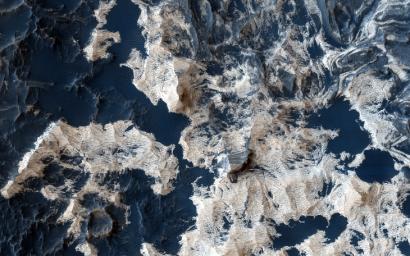
|
Layers and Sand on the Floor of Schiaparelli Crater
- Click the image above for a larger view
- Full-Res JPEG (2880 x 1800) (1.0 MB)
- Full-Res TIFF (2880 x 1800) (15.6 MB)
Caption:

Map Projected Browse Image
Click on the image for larger version
Schiaparelli Crater is a 460 kilometer (286 mile) wide multi-ring structure. However, it is a very shallow crater, apparently filled by younger materials such as lava and/or fluvial and aeolian sediments.
Most of the floor is covered by a thin layer of dust, but in places where there are patches of dark sand, there is also well-exposed bedrock. This sand-bedrock association is commonly seen on Mars, and most likely, the sand is actively saltating (hopping in the wind) and kicks off the dust.
The enhanced-color cutout reveals the relatively bright bedrock, which has a morphology similar to other deposits on Mars interpreted as "dust-stone," or ancient dust deposits that have been hardened into coherent bedrock.
In summary, one interpretation is that actively-moving sand kicks off the loose dust so we can see the hardened dust.
Background Info:
HiRISE is one of six instruments on NASA's Mars Reconnaissance Orbiter. The University of Arizona, Tucson, operates HiRISE, which was built by Ball Aerospace & Technologies Corp., Boulder, Colo. NASA's Jet Propulsion Laboratory, a division of the California Institute of Technology in Pasadena, manages the Mars Reconnaissance Orbiter Project for NASA's Science Mission Directorate, Washington.
Cataloging Keywords:
| Name | Value | Additional Values |
|---|---|---|
| Target | Mars | |
| System | ||
| Target Type | Planet | |
| Mission | Mars Reconnaissance Orbiter (MRO) | |
| Instrument Host | Mars Reconnaissance Orbiter | |
| Host Type | Orbiter | |
| Instrument | High Resolution Imaging Science Experiment (HiRISE) | |
| Detector | ||
| Extra Keywords | Color, Crater, Dust, Map | |
| Acquisition Date | ||
| Release Date | 2014-07-30 | |
| Date in Caption | ||
| Image Credit | NASA/JPL-Caltech/Univ. of Arizona | |
| Source | photojournal.jpl.nasa.gov/catalog/PIA18635 | |
| Identifier | PIA18635 | |
